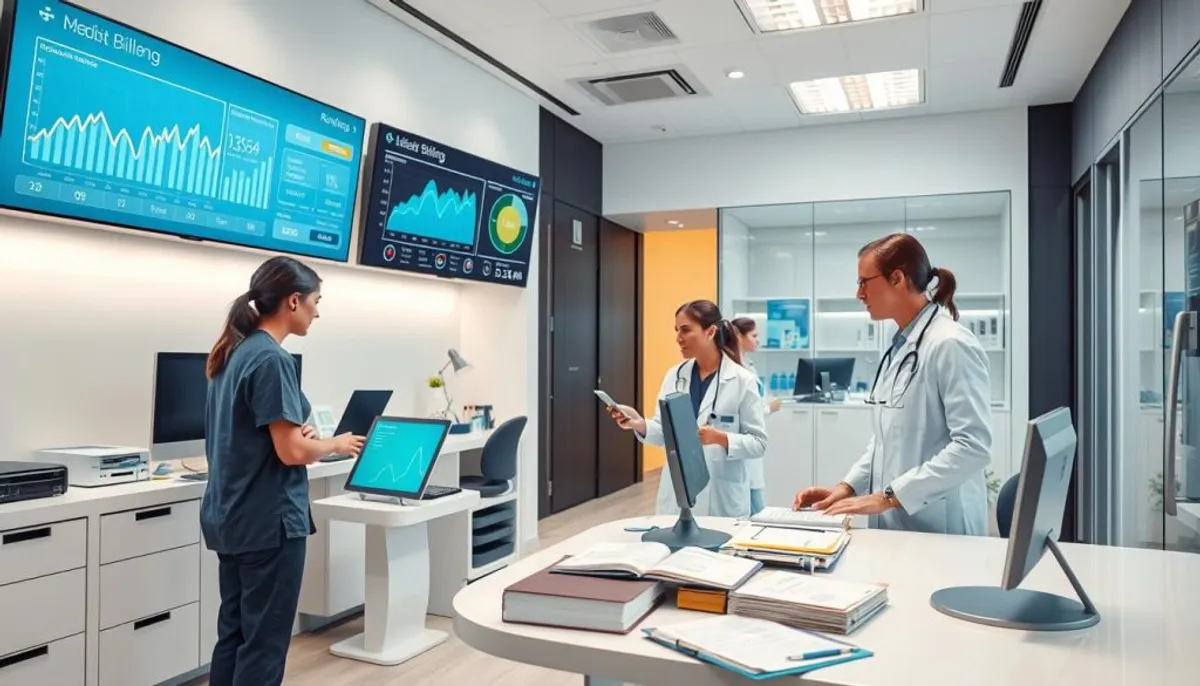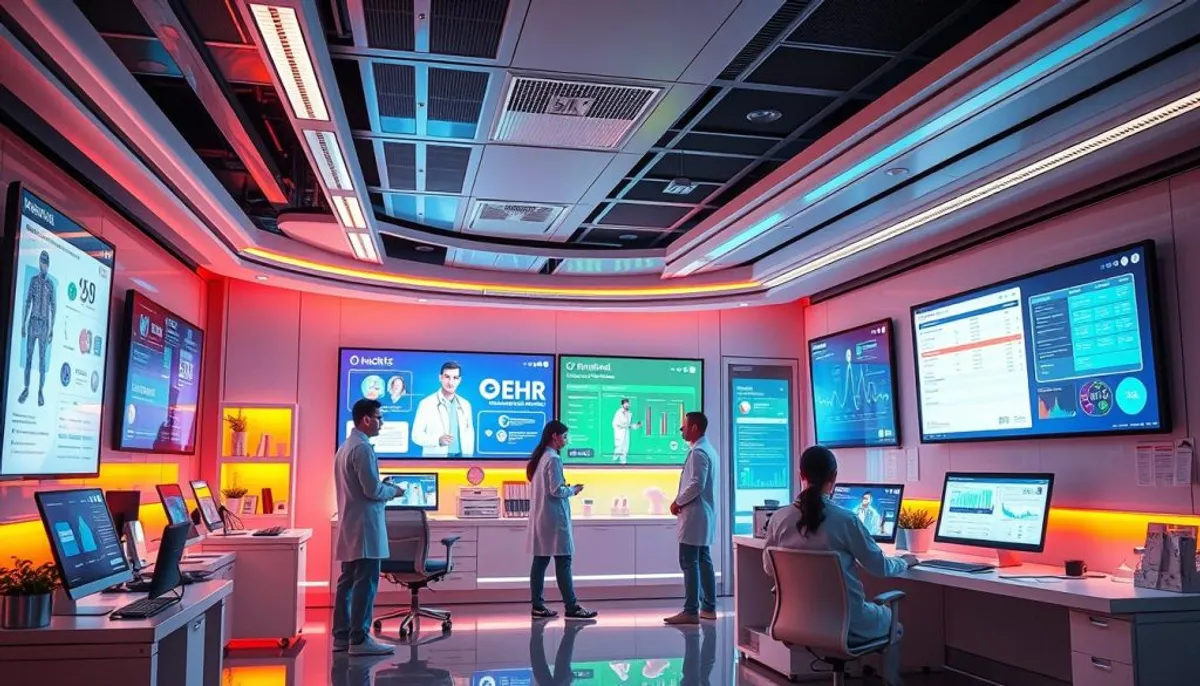In today’s healthcare landscape, maintaining financial stability through efficient accounts receivable management is paramount. The healthcare revenue cycle is fraught with challenges, with many providers finding it difficult to keep pace. Data reveals that over 40% of healthcare organizations lose 10% or more to revenue leakage, with 23% being oblivious to their leakage costs.
Medical billing automation has emerged as a transformative force for many facilities. By adopting technology, providers can diminish errors, streamline claims, and uncover valuable insights into their operations. This transition towards automation is critical, given that many U.S. hospitals operate on thin margins. Rural hospitals, in particular, are closing at alarming rates since 2005.

Implementing effective AR strategies can profoundly impact a provider’s financial health. For example, collecting patient copays before departure can mitigate revenue loss, as nearly half of all patient financial responsibility often becomes bad debt. By adopting robust accounts receivable management practices, healthcare organizations can enhance cash flow, lower operating costs, and optimize reimbursement.
Revenue cycle management (RCM) is a pivotal component of healthcare operations. It encompasses the financial transactions from patient intake to collections. The medical billing process, a core element of RCM, ensures timely payments for healthcare services.
RCM is essential for the financial stability of healthcare facilities. It optimizes the medical billing process, minimizing errors and enhancing reimbursements. This enables providers to concentrate on quality care while maintaining a consistent cash flow.
The RCM process encompasses several critical steps:
Effective RCM significantly influences provider sustainability. It ensures a predictable income, enabling healthcare facilities to pay staff and invest in patient care improvement. The RCM market is projected to exceed $238 billion by 2030, underscoring its increasing importance in healthcare operations.
Implementing efficient RCM processes saves time and resources. This allows staff to focus on delivering quality patient care. Achieving a balance between financial management and healthcare delivery is vital for long-term sustainability in the medical industry.
The medical billing workflow is crucial for effective accounts receivable (AR) management in healthcare. It starts with insurance verification, progresses through claim submission, and ends with payment posting. A well-organized AR billing system can notably decrease days sales outstanding (DSO) and enhance cash flow.
Claim submission is a pivotal step in the AR process. Healthcare providers must ensure claims are clean to avoid denials and delays. This entails accurate coding, proper documentation, and timely submission. Adopting electronic claim submission can expedite the process and diminish errors.
Payment posting marks the end of the AR cycle. It involves recording payments from insurance companies and patients. Efficient payment posting practices include:
Effective AR management hinges on key performance indicators (KPIs). These include a Collections Effectiveness Index (CEI) near 100%, DSO under 30 days, and a high Accounts Receivable Turnover Ratio. Regularly monitoring these metrics aids in refining AR strategies and boosting financial health.
AR automation tools can reduce manual errors, accelerate invoicing, and offer real-time analytics. This technology can decrease time spent on cash collection by up to 80%. It allows staff to concentrate on more intricate billing issues and patient care.
Medical billing has undergone a significant transformation, evolving from manual processes to sophisticated, automated systems. This evolution has profoundly impacted healthcare revenue management, enhancing both efficiency and accuracy.
Historically, medical billing relied on paper-based systems, which were error-prone and time-consuming. Today, the advent of medical billing software has streamlined operations, significantly reducing errors and accelerating payment collection. The Bureau of Labor Statistics forecasts a 9% increase in demand for medical billing professionals by 2031, underscoring the field’s critical role.
The integration of EHRs into medical billing has become indispensable in contemporary healthcare. By 2021, 78% of office-based physicians and 96% of non-federal acute care hospitals had adopted certified EHRs. This integration not only enhances data accuracy but also significantly improves patient care.

The advent of billing automation is revolutionizing healthcare finance. AI-powered systems are pivotal in this transformation, reducing paperwork and data entry errors. They also optimize cash flow by ensuring timely patient statements. The global healthcare cloud computing market, estimated at $39.4 billion in 2022, is projected to reach $89.4 billion by 2027, fueling further innovations in medical billing technology.
Healthcare billing necessitates adherence to stringent regulatory standards. Fraudulent billing activities have been estimated to cost over $100 billion annually. Thus, compliance is paramount for healthcare providers. HIPAA compliance, Medicare billing, and healthcare regulations are fundamental to ethical billing practices.
HIPAA compliance is vital for safeguarding patient data. Healthcare providers must deploy secure systems to protect personal health information. This entails utilizing HIPAA-compliant billing software and educating staff on data protection protocols.
Medicare billing adheres to specific guidelines to ensure accurate reimbursement. Providers must remain abreast of these rules to circumvent claim denials. The False Claims Act imposes severe penalties for fraudulent claims, underscoring the imperative for precise billing practices.
Adopting best practices in healthcare billing is crucial. This includes regular staff training, quality assurance measures, and staying current with regulatory updates. A robust compliance program is essential for preventing billing errors and upholding trust.
By prioritizing regulatory compliance, healthcare providers can circumvent penalties, diminish claim denials, and uphold their reputation. Collaborating with healthcare compliance experts can further mitigate risks and ensure adherence to evolving standards.
Efficient payment tracking and collections management are essential for healthcare providers to maintain financial stability. Implementing streamlined patient billing processes can significantly improve cash flow and reduce administrative burdens. This is crucial for the financial health of medical practices.
Monitoring the Average Days Sales Outstanding (DSO) is key. It measures the time to collect payments. A lower DSO signifies more efficient collections. The Collection Effectiveness Index (CEI) is also valuable, evaluating the success of collection efforts in converting outstanding receivables into cash.
Aging reports are vital in collections management. They categorize unpaid invoices based on duration. This insight helps identify potential collection issues and prioritize follow-ups. Automating these processes can reduce errors and expedite payment cycles, addressing common challenges in traditional collection methods.
To optimize payment collection, healthcare providers should consider implementing automated tools. These tools should include features like customer portals, streamlined workflows, and real-time reporting. This approach can lead to improved cash flow, reduced manual work, and enhanced efficiency in managing accounts receivable.
Insurance claim denials are a significant challenge for healthcare providers. Denial rates can reach up to 10% or more, leading to an average annual loss of $5 million for hospitals. This loss represents a substantial portion of net patient revenue, underscoring the need for effective claim management strategies.
Preventing claim denials begins with accurate coding and thorough documentation. Robust insurance verification protocols can significantly reduce rejections. By prioritizing quality over quantity, healthcare providers can optimize resources and time, ensuring claims are addressed effectively.
An organized appeals management process is essential for tracking and rectifying denied claims. The cost to rework or appeal denials averages $25 per claim for practices and $181 for hospitals. A dedicated team with expertise from various departments can streamline the appeals process, enhancing success rates.

Implementing stringent insurance verification protocols is crucial to reducing claim denials. This involves checking patient eligibility, benefits, and coverage before service provision. By verifying insurance information upfront, healthcare providers can minimize the risk of denials due to coverage issues or inaccurate patient data.
By adopting these strategies, healthcare providers can maintain denial rates below 5% and enhance overall reimbursement rates. Effective claim management not only boosts financial performance but also ensures smoother operations and better patient care.
The realm of patient billing has evolved, simplifying interactions between healthcare providers and patients. Clear communication regarding treatment costs and billing processes fosters trust and alleviates anxiety. Many patients face difficulties with insurance terminology, leading to confusion and financial burdens.
Healthcare organizations are now implementing patient engagement strategies to overcome these hurdles. Online portals, mobile apps, and secure messaging platforms increase patient involvement in billing. Financial counseling services and dedicated support lines offer personalized assistance, aiding patients in understanding their bills and exploring payment options.
Customizing communication to meet individual needs is essential for effective engagement. Some providers offer incentives like discounts or loyalty points to encourage participation. Patient feedback, collected through surveys and focus groups, offers insights into billing preferences and challenges.
Engaging patients effectively contributes to successful revenue cycle management, enhancing both clinical outcomes and financial stability. Metrics such as patient satisfaction scores, collection rates, and days in accounts receivable measure the success of these efforts.
By prioritizing patient-centric billing practices, healthcare providers can optimize their financial processes while enhancing the patient experience. This approach benefits both patients and the organization’s financial health.
AR analytics are pivotal in enhancing medical revenue management. They enable healthcare providers to refine their financial operations, thus elevating overall performance. This is achieved through the utilization of data-driven insights.
Tracking KPIs is crucial for assessing AR success. Metrics such as Days in Accounts Receivable (DAR), claim denial rates, and collection percentages are key. These indicators pinpoint areas for enhancement and direct strategic maneuvers.
Advanced financial reporting tools facilitate the prediction of cash flow trends and the identification of potential issues. These tools empower organizations to make informed decisions, ensuring financial stability.
AR analytics empower healthcare providers to make decisions based on data. By analyzing trends in claim denials, payment patterns, and aging AR, organizations can implement targeted improvements to their revenue cycle management processes.
Implementing robust AR analytics and financial reporting systems can lead to significant improvements in revenue management. Healthcare providers who prioritize data-driven decision-making are better positioned to navigate the complex landscape of medical billing and maintain financial health.
AR automation is transforming the financial landscape for healthcare providers, enhancing cash flow optimization. It streamlines payment processing, boosting efficiency in financial operations. This technology offers numerous benefits, including improved financial management and patient care.
Automated payment processing brings substantial advantages to healthcare organizations:
To effectively implement AR automation, follow these steps:
Assess the return on investment of AR automation by monitoring:
By adopting AR automation, healthcare providers can greatly enhance their financial performance. This allows them to focus more on delivering quality patient care.
In the realm of medical revenue management, ti3 emerges as a pioneering SaaS platform, dedicated to confronting overdue accounts head-on. It revolutionizes the collections process, automating everything from sending reminders to escalating issues. This ensures a highly efficient approach to managing accounts receivable.
Healthcare providers can bid farewell to traditional debt collection agencies with ti3. This innovative platform offers a cost-effective alternative that preserves positive client relationships while delivering superior outcomes. It empowers users to automate their AR management processes, enhancing cash flow and reducing time spent on collections.
The core strength of ti3 resides in its automated reminders feature. Research indicates that payment reminders sent near due dates significantly boost the chances of timely payment. This timely communication is vital for effectively managing overdue invoices, given that 49% of invoices issued by US businesses were overdue in 2022.
Ti3’s collections management capabilities tackle a pervasive issue. A Sage survey found that about 30% of small and medium-sized businesses suffer adverse effects from unpaid invoices. By introducing flexible payment options through ti3, healthcare providers can reduce late payments by up to 60%, thus enhancing their financial health.
Embrace the future of AR management with ti3. This SaaS platform not only streamlines your collections process but also fosters positive client relationships. It sets a new benchmark in medical revenue management.
AR billing optimization is a vital component of effective healthcare financial management. It leverages modern technologies and streamlines processes, significantly enhancing revenue cycle efficiency. This transition from traditional to automated systems has revolutionized financial management in healthcare.
Adopting advanced AR management solutions, such as those provided by ti3, can dramatically improve cash flow and financial health. These tools decrease operational costs and improve patient engagement through accessible payment options. As the healthcare sector evolves, staying at the forefront of AR management is essential for enduring success.
Efficient AR processes are directly linked to a company’s financial stability. Metrics like the accounts receivable turnover ratio and days sales outstanding analysis offer crucial insights into fiscal health. By focusing on these indicators, healthcare organizations can make informed decisions to optimize their revenue cycle. This ensures sustainable growth in a rapidly changing industry.